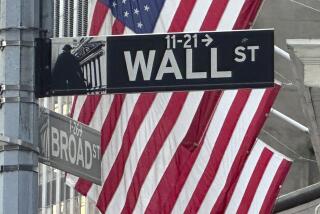Economic Data Hint at Slowing
Industrial production and consumer sentiment reports came in on the weak side Friday, providing more support for the view that higher oil prices could lead to slower U.S. growth in the second quarter.
The Federal Reserve said U.S. industrial production rose 0.3% in March, as expected, but February’s increase in output was revised down to 0.2% from the 0.3% previously reported.
The latest measure of April consumer confidence also bespoke a more uncertain economic outlook as energy costs soared. The University of Michigan’s consumer sentiment index released Friday slid to 88.7 from 92.6 in March.
Also on Friday, the Labor Department reported that rising oil costs pushed an index of U.S. import prices up 1.8% in March, the biggest gain in more than two years. Excluding a 10.6% jump in the cost of imported petroleum, import prices increased just 0.3%.
“It seems ... that higher oil prices are having an effect on both businesses and consumers,” said Elisabeth Denison, economist at Dresdner Kleinwort Wasserstein. “So the momentum of economic activity going into the second quarter is less vigorous than we expected.”
For the current month, the Federal Reserve Bank of New York’s report that its gauge of regional manufacturing fell in April to its lowest level in two years sharpened the impression that industry output was softening.
On the inflation front, however, March’s capacity usage -- the portion of the nation’s mines, factories and utilities used in production -- rose to 79.4%, a lower level than forecast, easing worries about incipient inflation pressure.
Reflecting record high gasoline prices that have soaked up consumers’ disposable income, the University of Michigan’s consumer expectation index fell to 79.0 from 82.8, while consumers’ view of current conditions fell to 103.9 from 108.
Consumer spending is the backbone of the U.S. economy, accounting for two-thirds of overall activity, so a drop in confidence could be a precursor to softer growth, economists said.
Last summer’s “soft patch” in the economy was also linked to a surge in gasoline prices.
The Michigan survey was only the latest piece of evidence that the world’s largest economy could face tougher times after about two years of robust growth.
Earlier this week, retail sales figures for March suggested that shoppers were spending more cautiously, while a record trade deficit indicated that domestic demand for imported goods far outpaced foreign interest in American products.
Given that reality, many on Wall Street have begun revising down their forecasts for first-quarter gross domestic product, predicting an expansion closer to 3.5% rather than the 4% consensus that had prevailed until this week.
Despite the challenges facing the economy, foreign appetite for U.S. assets remained robust in February. The Treasury Department reported that net inflows of capital into U.S. assets in February totaled $84.5 billion, below the previous month’s level, but still much greater than forecasts ranging from $55 billion to $70 billion.
More to Read
Inside the business of entertainment
The Wide Shot brings you news, analysis and insights on everything from streaming wars to production — and what it all means for the future.
You may occasionally receive promotional content from the Los Angeles Times.










